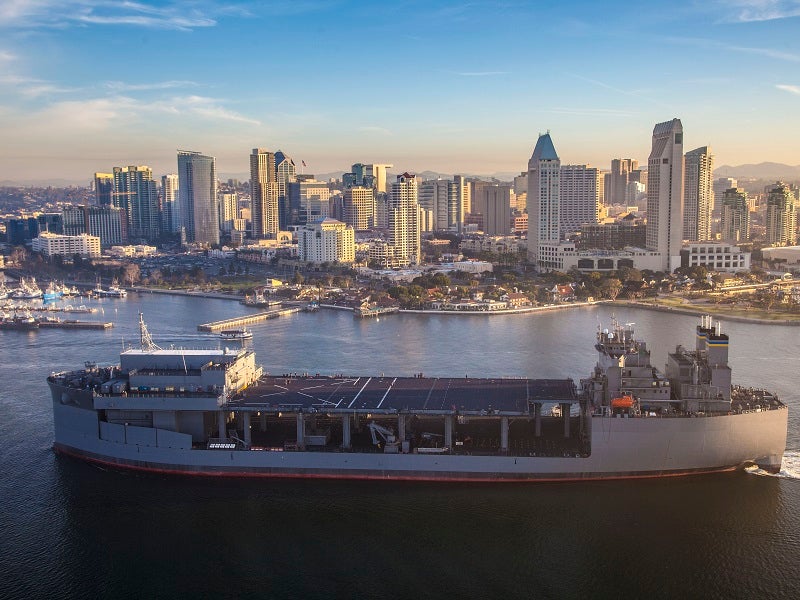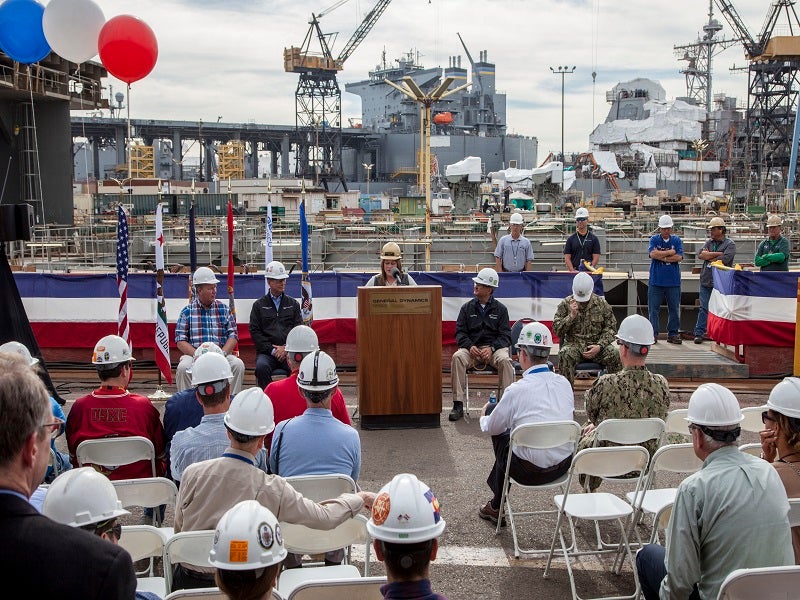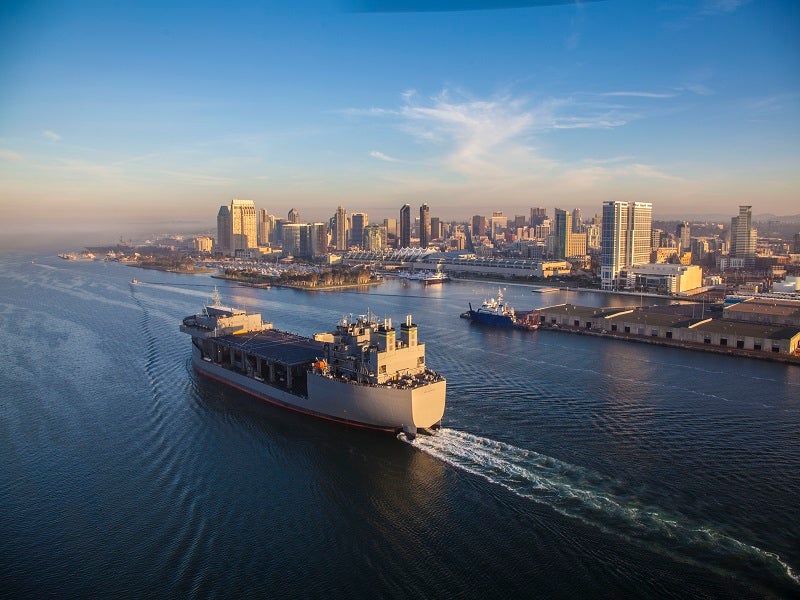The Expeditionary Transfer Dock (ESD) and Expeditionary Sea Base (ESB) are a new class of auxiliary vessels built by General Dynamics for the US Navy.
The ESD was formerly known as Mobile Landing Platform (MLP) while the ESB was known as Afloat Forward Staging Base (AFSB).
In April 2011, the US Navy placed a contract with General Dynamics National Steel and Shipbuilding Company (NASSCO) for the detailed design and construction of two ESD ships.
In May 2011, General Dynamics NASSCO was awarded a $744m modification contract by the US Navy for the construction of the first two ESD vessels.
The US Navy Strategic and Theatre Sealift programme in the Programme Executive Office (PEO) Ships is responsible for the procurement of the ESD/ESB ships. In January 2012, the first three ships in the ESD/ESB programme were named USNS Montford Point (ESD 1), USNS John Glenn (ESD 2) and USS Lewis B Puller (ESB 3).
The US Navy announced a new ship designation, ‘E’, for expeditionary support in September 2015. The MLP and AFSB were redesignated to conform to the traditional three-letter ship designations of the US Navy.
ESB design and features
The ESB concept was tested through a series of at-sea trials by the US Navy. A surrogate ESB ship and roll-on/roll-off vessel were used in exercises to demonstrate ability in high sea states.
The design of the ESB is based on the Alaska-class tanker. The base design incorporates the core capability set, accommodating vehicle scaffolding area, vehicle transfer ramp, skin-to-skin fenders and lanes for three landing craft air cushions (LCACs).
The ESB ship has a length of 239m, beam of 50m and design draft of 12m. The full load displacement of the vessel is 80,000t. Each ESB is manned by a crew of 34 personnel from Military Sealift Command (MSC).
The ESB ships allow the transfer of vehicles and equipment from large medium-speed roll-on/roll-off (LMSR) and joint high-speed vessels (JHSV) to shore using LCACs in Sea State 3 conditions. The MLPs allow amphibious operations in the absence of ports. The ship is equipped with a mission deck and float-off (FLO/FLO) technology, allowing loading and unloading of floating cargos.
The ship has storage tanks for 100,000gal of potable water and 590,000gal of JP5 fuel. The mission deck can accept future platform upgrades, including command and control, vehicle transfer system, cranage, accommodation module, medical facilities, and a helicopter landing spot.
The AFSB variant features a 52,000ft² flight deck, equipment and fuel storage, berthing and repair spaces, and can accommodate up to 250 personnel.
The mission applications include air mine countermeasures (AMCM), maritime security operations, counter-piracy operations, disaster response missions and US Marine Corps crisis response. Furthermore, the ESB can also support MH-53, MH-60 and MV-22 tilt-rotor aircraft missions.
Construction of ESD/ESB
The construction on the first ship in class, USNS Montford Point (ESD 1), began at the NASSCO shipyard in San Diego, California, in June 2011. The keel was laid for MLP-1 in January 2012.
The final structural welds were inspected by the American Bureau of Shipping and US Navy once completed. The construction of the first ESD was completed in September 2012. The fabrication process on the second ship began in April 2012. Each ship was installed with core capability set (CCS) modules after delivery from NASSCO. A request for proposal (RFP) was issued for the core capability set (CCS) for the ESB in March 2012.
The USNS Montford Point (ESD 1) was delivered in May 2013. The ship achieved initial operational capability (IOC) in 2015.
The second ship in class, USNS John Glenn (ESD-2), was launched in September 2013 and completed builder’s sea trials in January 2014. It was delivered to the US Navy in March 2014.
The US Navy placed a detailed design and construction contract for ESB 3 (earlier termed MLP 3), the third ship, in February 2012. The keel for ESB 3 was laid in November 2013, while the christening ceremony was held in February 2015, and the vessel was delivered in June 2015.
The third ship in the programme, and the first in the ESB class, is known as USS Lewis B Puller (ESB 3). It was commissioned during a ceremony held at the Khalifa bin Salman Port in Al Hidd, Bahrain, in August 2017. The ship replaced the AFSB (Interim) USS Ponce.
NASSCO was awarded a $498m contract by the US Navy for the detailed design and construction of the fourth in the ESD/ESB project in December 2014. The long lead contract for the fifth ship followed in June 2016. The fourth and fifth ships were named USS Hershel ‘Woody’ Williams (ESB 4) and USS Miguel Keith (ESB 5).
Construction of the fourth ship (ESB 4) began in October 2015. ESB 4 was delivered to the US Navy’s Military Sealift Command in February 2018, and commissioning took place in March 2020.
Construction of ESB 5 began in January 2017. The USS Miguel Keith was delivered to the US Navy in November 2019 and was commissioned at Naval Air Station North Island, Coronado, California, in May 2021.
A contract worth up to $1.6bn for the construction of ESB 6, ESB 7 and an optional ESB 8 was awarded to NASSCO in August 2019. The USS John L Canley (ESB 6) is under construction. Construction of the USS Robert E Simanek (ESB 7), the seventh in the class, began in December 2021.
Propulsion
The ESD/ESB ships are powered by a twin-screw, diesel-electric propulsion system integrating four MAN/B&W N 6L48/60 Common Rail (CR) medium-speed diesel engines, a 24MW diesel-electric plant and 2MW azimuthing bow thruster. The propulsion system provides a sustained speed of 15k and endurance of more than 9,500nmi at 15k speed.
In August 2011, Converteam was awarded a contract by General Dynamics NASSCO to supply propulsion, electric power, generators and automation systems for the MLP programme.
Fairbanks Morse was awarded a contract to provide four FM | MAN 6L48/60 Common Rail (CR) engines for ESB 6 in November 2019. Each engine will have a rated power of 6,480kW. The key components include a common high-pressure fuel header, electronically-controlled fuel delivery, high-pressure pumps, electronic governing and new control system.
The CR technology is intended to enable higher power output, better engine responsiveness and reduced fuel consumption as well as emissions. The earlier generations of engines can be retrofitted with this technology.







